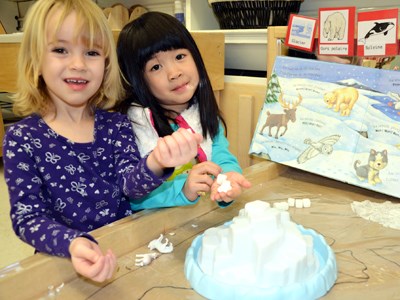In Early Learning – Kindergarten in Rainbow schools, the classroom is a third teacher.
The concept comes from Reggio Emilia preschools in Italy. The classroom design invites children to make choices, solve problems and learn on their own and in groups.
In the French Immersion program in Rainbow Schools, the learning environment is designed intentionally to promote the exploration and acquisition of French as a second language.
Teacher Julie Kelly and Early Childhood Educator Lynne Lundrigan have been working together in the Early Learning French Immersion Program in Rainbow Schools for three years.
In their classroom, children play with language and its sounds. Learning French is a natural process.
For example, children created a sound machine, which started with moving objects through tubes, and turned into an exploration of sound and voice through the tube. Then they began playing with French words and sang French songs.
Four-year-old Lucas, who came into French Immersion with no prior exposure to the French language, decided to take a song the class had learned together and rewrite the lyrics — en français — based on his interest in dinosaurs.
Lucas and Lynne Lundrigan took turns writing the lyrics on paper. Lucas then decided to sing the song for his classmates and make it into a game.
Kelly said “Lucas’ contagious enthusiasm for the French language inspired others to experiment with sound, writing and drama.”
The educators observed that the open-ended nature of a play-based environment motivates children to speak French by building on their interests.
They provided another good example. When it became cold outside, the children in the Early Learning French Immersion class at R.L. Beattie Public School were curious about the changes on the playground. One day, the puddles of water turned to ice.
“C’est de la glace!” they exclaimed.
“Pourquoi?” (why?) asked the educators.
“Because it was snowing and it froze,“ said Jameson.
Julian added, “It’s too cold for the water to stay.”
“It’s almost winter,” said Olivia.
“The Weather Network will tell us when it will freeze,” suggested Lane.
The conversation turned to temperature and how it is measured using a thermometer.
“We talked about the properties of ice and water and what makes them different,” said the educators. “Quelle est la différence?” they asked.
“We predicted whether puddles of water will be frozen when we go outside for an outdoor inquiry.” “Qu’allons nous voir?”
From this inquiry, the children learned new words: “L’eau, la glace, gelé, froid, thermomètre, regarde, chaud, température, l’automne, l’hiver.”
In Early Learning, educators capitalize on children’s interest to dig deeper. Lately, the children have been fascinated about the world.
As the class researches what countries they need to include on a map they are making, the children talk about the north and south poles.
“Who lives in the North Pole and in the South Pole?” they ask.
“Together, we read books about Antarctica and the Arctic and learn about the ice, icebergs, igloos, animals (including l’ours polaire/the polar bear) and people who live in these cold climates and introduce French vocabulary,” says Kelly.
Children extend their learning by building igloos with interesting materials such as blocks, sugar cubes and ice. Children make connections with their inquiries about ice and water, leading to discussions about permafrost.
By learning through doing, children take ownership of the language, have freedom to explore French at their own pace and enjoy their individual and collective journeys.
French Immersion immerses children in the French language, including cultural experiences, when they begin school.
English-language instruction is introduced in Grade 3 and gradually builds to an equal balance of French and English instruction by Grade 5. This ensures that students gain effective bilingual skills.
Norm Blaseg is Director of Education for Rainbow District School Board.
Join Sudbury.com+
- Messages
- Post a Listing
- Your Listings
- Your Profile
- Your Subscriptions
- Your Likes
- Your Business
- Support Local News
- Payment History
Sudbury.com+ members
Already a +member?
Not a +member?
Sign up for a Sudbury.com+ account for instant access to upcoming contests, local offers, auctions and so much more.
